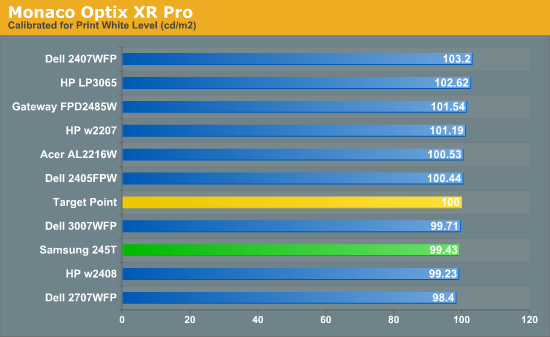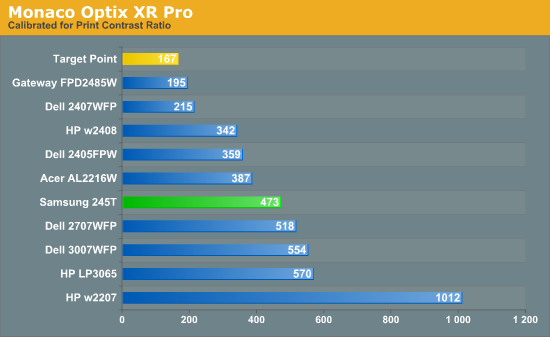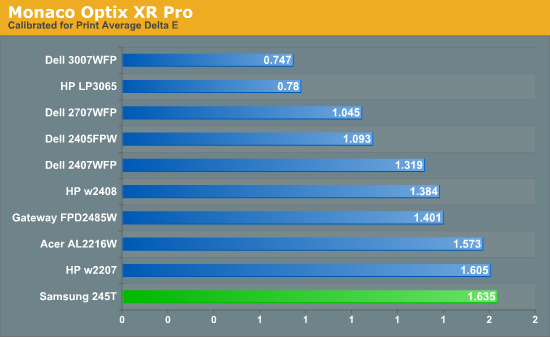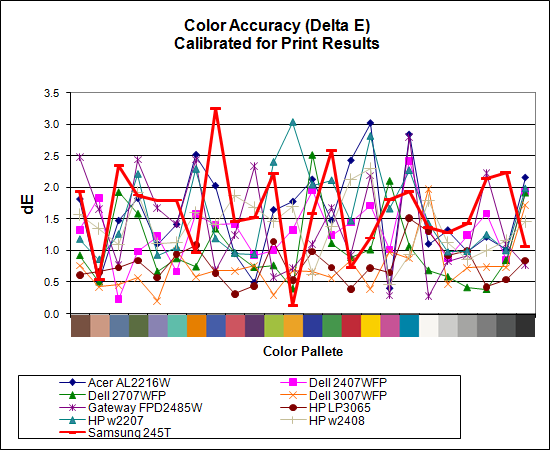Printing
Results
Brightness and Contrast Ratio
For those who have a need to match colors between their computer displays, cameras, and printers, what works well for computing purposes often isn't the best suited for doing other image related work. To help people who work in such areas match their computer colors to their paper colors better, standards were established. For print work, the standard is a gamma of 2.2, a black point of 0.60 nits, and a white point of 100 nits. We attempt to calibrate all the monitors for these settings.
Finding the appropriate settings to reach these levels can be a time-consuming process for some of the displays. It may require numerous iterations through the calibration process to end up with the desired white point, and on some LCDs it might not even be possible to reach a satisfactory result (though that hasn't occurred yet). The nature of LCDs is such that we are unable to get both an accurate white point and an accurate black point according to printing requirements (our black levels always ended up darker than they are supposed to be), but we did manage to get near the desired 100 nits white point on all of the tested displays. For the Samsung 245T, we used brightness/contrast settings of 13/75, with RGB at 16/21/36. We tried several other settings, but all others scored worse so we settled on these values.
For reference, we have included the target value in the following graphs, so the greater the deviance of a display from the targeted value, the less suitable (in theory) a display becomes for print work.



Since very slight differences in brightness are not a huge deal, we did not attempt to get 100% accuracy on the white point, but further tuning of the various displays would have made it possible to get closer to 100 nits. The primary goal was to get the white point near 100 nits. The target black point is impossible to achieve once we have reached the target white point with any LCD that we have tested to date - and we expect that trend to continue. Due to the reduced brightness, contrast ratios are often lower, but that is inherent with the target settings. The Samsung 245T is pretty average when it comes to "calibrate for print" brightness and contrast ratio.
Color Accuracy
Given the importance of accurate colors for printing work, we need to adjust the desired Delta E scale. A Delta E of less than 1.0 is definitely the goal here, and 1.0 to 2.0 is merely acceptable. Scores above 2.0 generally mean a display is not fit for printing professionals.


At the reduced brightness setting used in this test, the Samsung 245T doesn't score as well as it does in other areas. In fact, it's technically the worst LCD we've tested so far -- at least in terms of raw score -- when it comes to calibrating the display for print work. Considering that all of the displays do reasonably well in this test, however, this probably isn't a big enough concern that we would strongly recommend a different display, other than one of the 30" LCDs on the market. Whether it's their use of S-IPS panels or something else, we can't say, but the 30" LCDs that we've tested have the lowest Delta E scores of any of the monitors.










60 Comments
View All Comments
alainiala - Friday, February 8, 2008 - link
I do A LOT of monitor testing at my work because I'm one of a handful of people responsible for setting our enterprise hardware standards. I try to steer our company away from TN-based panels, but sometimes its unavoidable (all but one 22" panel that I'm aware of are TN). I find S-PVA to be acceptable, but the true beauties are the S-IPS monitors. NEC makes some of the best S-IPS monitors around, but they are very pricey. My favorite monitors is undoubtably the NEC 2490WUXi, but you have to be prepared to sell an organ to get one. Not worth it for the average user, but anybody with color-critical apps should take a long hard look at it. I do wish more manufacturers would stick with S-PVA and S-IPS... But alas, the pricepoints demand we all get stuck with TN garbage.Pjotr - Friday, February 8, 2008 - link
TVA -> PVAJarredWalton - Friday, February 8, 2008 - link
Fixed, thanks - after writing an article for so many hours, some things start to blur past your eyes. :)uethello - Thursday, February 7, 2008 - link
The panel being listed as TN is ominous to me. I've been studying monitors hard for about a month (since I found out how much of my money Uncle Sam is giving me). Seems like some manufacturers build monitors with both types of panels. Going for the "Hope" buy, I guess. The person who hears about someone getting a good panel and buying in the hopes of not getting a TN.JarredWalton - Friday, February 8, 2008 - link
I talked to my contact at Samsung and got this response on the panel:"As to your question, the 245T does have an S-PVA panel, which is a far superior technology than TN, not that I need to tell you that. The 245BW uses a TN panel. The proper authorities have been notified and they’re working on fixing [the PDF] immediately. I appreciate you letting me know."
So no worries - the 245T is an S-PVA panel as reported and as the images show.
Dainas - Thursday, February 7, 2008 - link
...all manufacturers are seemingly phasing out all mva/pva panels below $650, replacing them with TN at the same pricepoint and no one cares. It surprises me that the reviewers despite not being a big fan of $500+ TN panels, have not noted this plain as day trend.JarredWalton - Thursday, February 7, 2008 - link
Ummm... did you read my HP w2408 review? I pretty much slammed on that trend and said that IMO the TN panels still suck by comparison. I also praised this LCD for not being a TN panel. How is that "not noting the trend"?Dainas - Thursday, February 7, 2008 - link
ok, you noted that much :P Except for what amount to closeout deals, we are starved for choice compaired to 6 months ago. Its not just a matter of waiting for things to get back up to swing after the chinese new year. Besides the expensive stalwarts such as this and the dells line, TN is just eating up everything else was :(I would expect nothing short of a full blown rant about this, hehe.
strikeback03 - Friday, February 8, 2008 - link
Aside from closeout deals and Black Friday specials and the like, have there ever been 24" LCDs that didn't use TN panels available "cheaply"? Seems that when the 24" LCDs were initially all good panels and all expensive, then as more came out the prices dropped some, then someone started making 24" TN panels and those monitors formed a whole separate price bracket.JarredWalton - Friday, February 8, 2008 - link
I believe there are some S-PVA 24" panels for around $400-$450. Are they good LCDs, or are they the reject S-PVA panels that couldn't be put in $600 LCDs? I don't know - I'd like to get one to test, but unfortunately the budget LCD companies aren't interested in sending us review samples. Anecdotally, I've heard that while they are usually better than TN panels, they've got other issues - firmware, low build quality, etc.